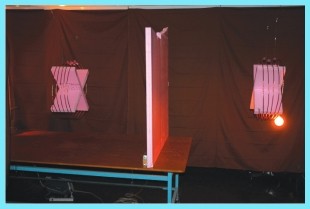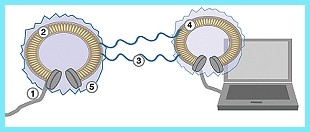Wireless Power
By brother-initiate Guo, Michigan, USA (Originally in English)
Have you imagined charging your cell phone, MP3s, PDAs or even laptop computers without plugging them into a power supply, but instead charging them up remotely? This may soon come true thanks to a recent experiment conducted by scientists at the Massachusetts Institute of Technology (MIT).
 |
| 60W light-bulb being lit from 2m away from the energizing coil (left) powered from the wall plug. Note the obstruction placed in between the two coils. |
The wireless energy transfer is based on a well-known physical phenomenon called resonance—energy can be transferred between two objects when they are tuned into the same frequency. In fact, the basic idea of transporting electrical energy using high frequency electromagnetic waves has been suggested in the nineteenth century by the great American inventor Nikola Tesla.
Apart from the resonance effect, the MIT team made use of two other effects to demonstrate the efficient energy transfer. The first they used was a so-called “near field effect” from a source capable of generating radio frequency electromagnetic waves. However, unlike the radio station, which sends information-carrying electromagnetic waves far distances to reach many listeners, the coils used by the MIT scientists delivered electromagnetic energy only to nearby coils, thereby making the energy transfer much more efficient and direct. The second trick was to use magnetic resonance because humans and most everyday objects such as electronic devices, wood furniture, and metallic objects have negligible response to magnetic fields. Therefore, the energy transfer is not visibly affected by these objects. As shown in their experiment, even with a wood board placed in between the two resonant coils, the light bulb on the opposite side of the energy source still lit up with equal brightness.
So what are the potential applications? The scientists think that it is possible to make the receiving coil small enough to fit into portable devices without decreasing the power transfer efficiency. One day we may not need to carry many different types of power supplies for our multitude of electronic gadgets.
One day, our cars may even be powered
by energy coming from these coils underneath the highway! This could cut
down drastically the consumption of fossil fuels and the global CO2 production.
Is this a total fantasy? Not for those people who have come up with such
interesting applications and who have a strong desire to explore this
new way of transferring energy wirelessly. ![]()
 |
| 1. Power from mains to antenna, made of copper. 2. Antenna resonates at a frequency of 6.4MHz, emitting electromagnetic waves. 3. ‘Tails’ of energy from antenna ‘tunnel’ up to 5m (16.4ft). 4. Electricity picked up by laptop’s antenna, which must also be resonating at 6. 4MHz. Energy used to re-charge device. 5. Energy not transferred to laptop re-absorbed by source antenna. People/other objects are not affected as they do not resonate at 6.4MHz. |
|
||||||